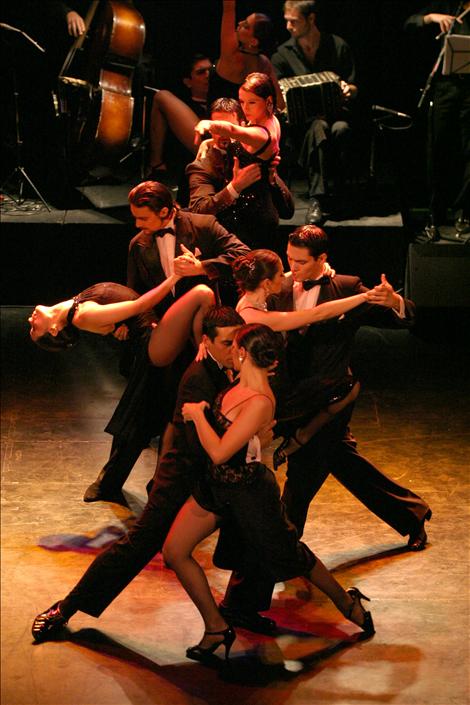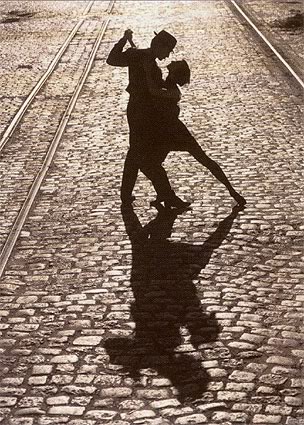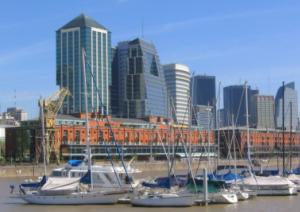Tour Outline (abbreviated): (click on pictures to toggle size) Our Tango Night out comes in two flavours: the Mild and the Wild tango night-out. The Mild one is the most advisable for beginners. Chances are you go 'wild' about Tango, and then you can ask us to take you to the Wild Tango Night-out, where you will be sharing the dance with 600 wild local tango dancers till the wee hours of the morning. Until you make this decision we suggest you start with the unforgettable Mild Tango Night Out: The perfect mix of dinner-show and local experience (you can dance with the locals: beginner lessons are included).
 'Mild' Tango Night-out:
'Mild' Tango Night-out:
Price: US$148 p/p (one or more ppl. � no minimum)
Meeting Point: We pick you up at your hotel
End Point: We will take you back to your hotel just around midnight
Departures: Everyday of the year, at around 6:45pm
'Description: This is an approximately 4 hr evening Tour. We choose for you a tango dance hall and take you there. There are many to choose from: tango shows where hundreds of people get together, enjoy a great show, food, drinks and -if you feel like it- dance, learn to dance, or just watch. Where we take you, the lessons are included (if you are so inclined); they are truly fun for
all ages, and not difficult at all. You can take lessons whether you have a dancing partner or not (if you have one, then he or she can give it a try... or just look!). In all cases teachers will teach, show and coach, and you will dance with other people at your level of skill. You can move between levels as you feel comfortable or just watch the really good ones and learn. Please read the following generalities:
You dress casual (ladies, please do not bring along heavy purses or bags) and we pick you up at the lobby of your hotel between 6:45 pm and 7:15 pm. We then take you to a real tango ballroom (in local lingo we call them �Milongas� which is both the name of a form of tango and a generic denomination for place where you dance). When you arrive there, people may already be dancing. If you join the tango lessons, at the beginners level there is usually plenty of people, and you will be asked to watch and listen to the explanation of the basics (for a few minutes) and then you will be invited to try doing and imitating what has been just explained. Then the teachers will slowly add complexity and tricks and variants. Instructors go around paying each person attention and helping you out. Instructors are very friendly and they can usually explain in english. You can be alone, accompanied, young or old: there are usually as many men as there are women, and there will be lots of people of all ages, and you are welcome (and supposed to) change partners now and then (you don�t need to if you don�t feel like it) for this ensures everybody attains a similar skill-level, and it is also fun since you get to know people. The lesson continues for aproximately an hour. Then a great dinner �good and plenty, is served, made of very good local food. You can choose within a wide variety of dishes- and you can drink anything you like (i.e. pop, beer, wine). We usually suggest you order good argentine (unique) wines, like Malbec (red) and Torrontes (white). Then, suddenly the lights dim and professional dancers take to the floor dancing to a real-life tango orchestra and tango singers, and perform a top-quality tango show for everyones� delight (it is great to see how each couple dances or �dialogues� in their own way, since tango is like a danced "wordless or silent" romantic dialogue). Argentinean tango dancers are constantly striving to improve their skill, so you will see plenty of amazing, top quality tango being performed, played and sung.
'Wild' Tango Crawl:
Price: US$60 p/p (minimum 2 people or add 30%)
Meeting Point: 999 Corrientes Av. (just outside the 'Cafe de la Ciudad')
End Point: n/a
Departures: Wednedsay to Saturdays, around 8:30 pm
 'Description:
'Description:
4 hr Evening tour visiting different and varied �milongas�, where the tango lives!
Escorted by keen tango dancers, knowledgeable of the tango scene. Learn the first steps along with the hints and codes of tango. Get to know the real BA tango scene. We leave from the indicated spot and make our way (either Subway or taxi) to the different spots. Entrance tickets, transport, food, drinks are NOT included. But the costs are very low. Make sure you bring some Argentinean cash. Dress comfortably. Do NOT bring expensive, flashy jewelry
So what is Tango?
Although it has come to epitomize the glamour and elegance of high society, with women in sleek glittering evening gowns and men in tux and tails, the tango originated in society's underbelly--the brothels of turn-of-the-century Argentina. As immigrants from Europe, Africa, and ports unknown streamed into the outskirts of Buenos Aires during the 1880's, many gravitated toward the port city's houses of ill repute. In these establishments, the portenos, (as they were called,) could drown their troubles in a few drinks and find some companionship. They looked desperately for a distraction to ease their sense of rootlessness and disfranchisement as "strangers in a strange land."
From this heady, intermingled cultural brew emerged a new music which became the tango. Though musical historians argue as to its exact origins, it is generally accepted that the tango borrowed from many nations--the relentless rhythms that the African slaves--the candombe--beat on their drums (known as tan-go); the popular music of the pampas (flatlands) known as the milonga, which combined Indian rhythms with the music of early Spanish colonists; and other influences, including Latin. Some say the word "tango" comes from the Latin word tangere (to touch.)
Ironically, as these lonely immigrants and societal outcasts sought to escape from their feelings, they instead developed a music and dance that epitomized them. The wail of the tango, it is said, speaks of more than frustrated love. It speaks of fatality, of destinies engulfed in pain. It is the dance of sorrow.
Originally, the tango dance developed as an "acting out" of the relationship between the prostitute and her pimp. In fact, the titles of the first tangos referred to characters in the world of prostitution. These tango songs and dances had no lyrics, were often highly improvised, and were generally regarded as obscene. Further, the early tangos not only represented a kind of sexual choreography, but often a duel, a man-to-man combat between challengers for the favors of a woman, that usually ended in the symbolic death of an opponent. Sexual and evil forces were equally celebrated in this ritual. During this time, the wailing melancholy of the bandoneon (an accordion-like instrument imported to Argentina from German in 1886) became a mainstay of tango music.

With the advent of the universal suffrage law--passed in Argentina in 1912--the lower classes were allowed to vote, which served to legitimize many of its cultural mainstays, including the tango. As it became absorbed into the larger society, the tango lost some of it abrasiveness. The structure of the dance, however, remained intact, and soon the tango developed into a worldwide phenomenon. Even the Americans were doing it, although some ladies were given to wearing "bumpers" to protect themselves from rubbing a bit too closely against their male partners.
During the first two decades of the new century, the tango took Paris by storm. The blessings of the Parisians, in turn, made it a staple of Argentinean high society. Tango was reigning supreme in the cabarets and theatres frequented by the rich. Out of this culture, the tango musician became elevated to professional composer status. A pioneer in this genre, Roberto Firpo, created the typical tango orchestra--rhythm played on piano and double bass; melodies played on the bandoneon and the violin, with strong counter melodies and variations. The stars of this era were Osvaldo Fresedo and Julio de Caro.
In 1918, lyric writing for the tango become the latest trend, bringing forth the birth of a star who is still celebrated five decades after his death--singer Carlos Gardel. The memory of this handsome, charismatic performer has reached hero worship status in Argentina, not unlike what Elvis Presley inspires in the USA.
In 1930, a sudden military coup in Argentina ended the citizens' right to vote, and thus largely silenced the voice of the people, the tango. During this time, a very pessimistic philosopher/singer of the tango emerged, Enrique Santos Discepolo. He is famous for the line, "The 20th Century is a trash heap. No one can deny it.."
Tango revived in the late 1930's when the Argentinean masses regained a good measure of their political freedom. They celebrated their social rise with the tango, which became a symbol of their physical solidarity and part of their daily life. Again, tango musicians emerged who took the form in new directions including Fresedo, de Caro, Pugliese, and Anibal Troilo.
Soon, wealthy intellectuals, far removed from the working class, "orilla," began writing new lyrics for the tango. Because of their influence, tango took on a more romantic, nostalgic, and less threatening air, a sweet remembrance of youth in an idyllic society that never existed.
When Juan Peron rose to power in 1946 the tango again reached the pinnacle of popularity in Argentina, as both he and his wife Evita embraced it wholeheartedly. Yet, with Evita's death in 1952, the tango again fell from the mainstream spotlight. American rock-and-roll invaded the popular scene, and the tango again seemed out of step with its times.
Today the tango is enjoying a renaissance of popularity, keeping the fire of this daring art form burning brightly.



![]() When: 6:45pm, daily 365 days/year (this tour is only available by booking ahead through our 'Booking' menu entry above)
When: 6:45pm, daily 365 days/year (this tour is only available by booking ahead through our 'Booking' menu entry above)![]() Duration: 4-1/2 hours
Duration: 4-1/2 hours![]() Price: US$148 p/p (Mild - one or more ppl.) � US$60 p/p (Wild - minimum 2 ppl. or add 30%)
Price: US$148 p/p (Mild - one or more ppl.) � US$60 p/p (Wild - minimum 2 ppl. or add 30%)![]() Discounts: Discounts available for groups of 6 or more people: please call us
Discounts: Discounts available for groups of 6 or more people: please call us![]() Meet: We will pick you up at your downtown hotel and we will also take you back--usually around midnight
Meet: We will pick you up at your downtown hotel and we will also take you back--usually around midnight![]() Note: Our exciting Tango Night-out comes in two flavors:
Note: Our exciting Tango Night-out comes in two flavors: ![]() Some key sights:
Some key sights:

 'Description:
4 hr Evening tour visiting different and varied �milongas�, where the tango lives!
Escorted by keen tango dancers, knowledgeable of the tango scene. Learn the first steps along with the hints and codes of tango. Get to know the real BA tango scene. We leave from the indicated spot and make our way (either Subway or taxi) to the different spots. Entrance tickets, transport, food, drinks are NOT included. But the costs are very low. Make sure you bring some Argentinean cash. Dress comfortably. Do NOT bring expensive, flashy jewelry
'Description:
4 hr Evening tour visiting different and varied �milongas�, where the tango lives!
Escorted by keen tango dancers, knowledgeable of the tango scene. Learn the first steps along with the hints and codes of tango. Get to know the real BA tango scene. We leave from the indicated spot and make our way (either Subway or taxi) to the different spots. Entrance tickets, transport, food, drinks are NOT included. But the costs are very low. Make sure you bring some Argentinean cash. Dress comfortably. Do NOT bring expensive, flashy jewelry
 With the advent of the universal suffrage law--passed in Argentina in 1912--the lower classes were allowed to vote, which served to legitimize many of its cultural mainstays, including the tango. As it became absorbed into the larger society, the tango lost some of it abrasiveness. The structure of the dance, however, remained intact, and soon the tango developed into a worldwide phenomenon. Even the Americans were doing it, although some ladies were given to wearing "bumpers" to protect themselves from rubbing a bit too closely against their male partners.
With the advent of the universal suffrage law--passed in Argentina in 1912--the lower classes were allowed to vote, which served to legitimize many of its cultural mainstays, including the tango. As it became absorbed into the larger society, the tango lost some of it abrasiveness. The structure of the dance, however, remained intact, and soon the tango developed into a worldwide phenomenon. Even the Americans were doing it, although some ladies were given to wearing "bumpers" to protect themselves from rubbing a bit too closely against their male partners.

 button to book this tour
button to book this tour